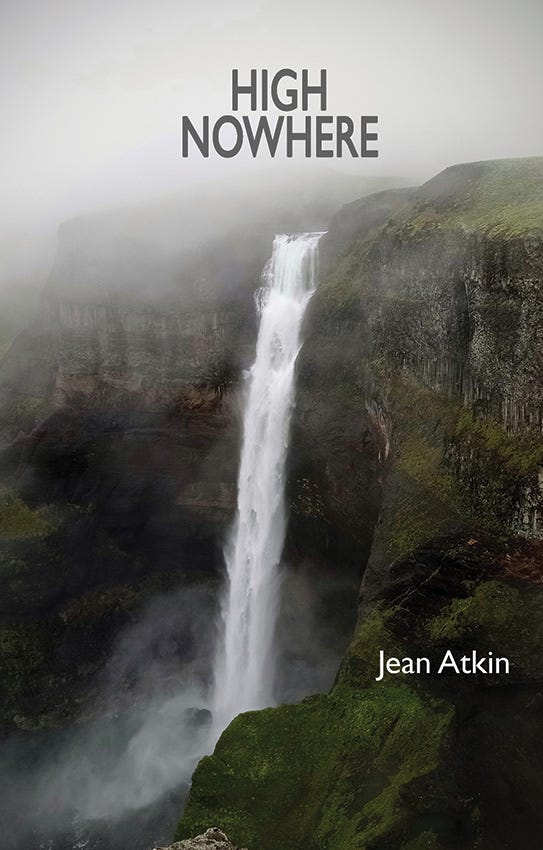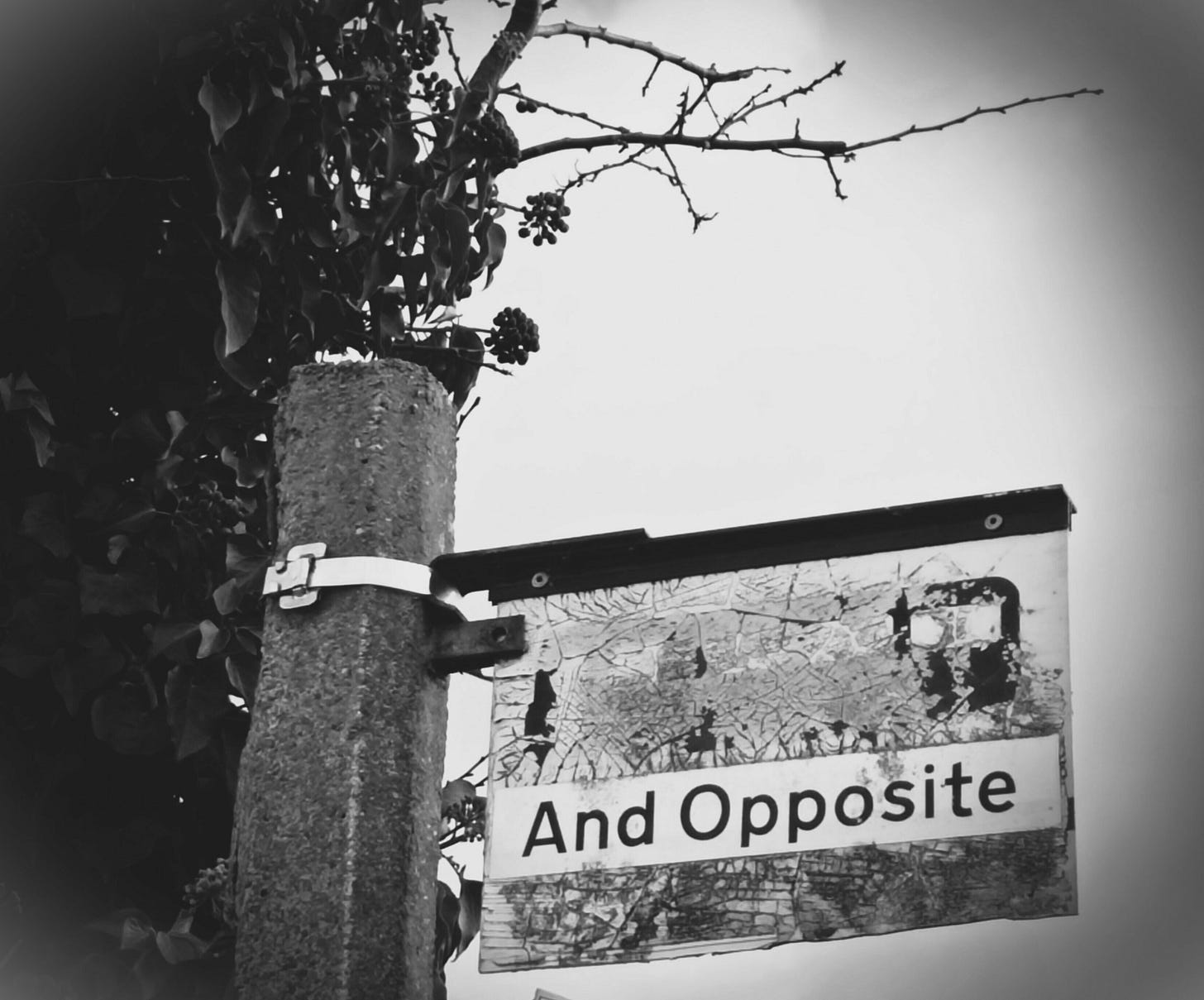Review of High Nowhere - the latest collection from Jean Atkin
Join me on my journey through this book of fury, landscape and hope
One of my most rewarding habits is to devote the first hour of my morning to reading or writing poetry. I don’t manage it all the time, but when I do it’s a wonderful way to begin the day.
For the last couple of weeks, I’ve used this hour to read and reflect on Jean Atkins’ latest collection High Nowhere. Each morning I’ve found something new, found poems that move me in a different way. This is a collection that commands attention. I’ve enjoyed rich description, honest fury, chilling insight and the sheer pleasure of reading a carefully constructed collection. I hope you’ll enjoy reading my review.
Review of High Nowhere – Jean Atkin , published by Indigo Dreams November 2023
‘I think that by retaining one’s childhood love of such things as
trees, fishes, butterflies and – to return to my first instance –
toads, one makes a peaceful and decent future a little more
probable, and that by preaching the doctrine that nothing is to
be admired except steel and concrete, one merely makes it a
little surer that human beings will have no outlet for their
surplus energy except in hatred and leader worship.’
George Orwell Some Thoughts on the Common Toad
A book that opens with one of my favourite George Orwell quotes is always going to have impact. High Nowhere does this but somehow combines chilling insight about the damage we have done and are doing, with threads of magical realism and familial tenderness. This collection took me on a journey through the high lonely places, through majesty, into fable and fairy tale before rejoining the tentative hope of day to day living.
Brink
My boots left earth.
I tasted leaves.
Brink places me in the role of explorer. I travel with birds, walk with hunters and collectors. I embark on a journey through the multiple insults rained down on the natural world, through ignorant loss and foolish decision. These poems express simmering contempt, inexorable sadness and simple frustration.
The plaintive cry of the opening poem Ferme d’Isson hints not only at the global crisis, but the unique problems that England is facing as it moves to an ever more hostile attitude towards the natural world.
Brink is a pointed battle cry, a warning we have an opportunity to listen as well as being a tale of tender sorrow at all we have lost
We blinked, you vanished, in the disappearing trees.
In twenty nineteen, you were classified extinct. We
found you, named you, lost you, in less than twenty years.
Ode to the Cryptic Tree Hunter
Spread
Behind the socially distanced queue blow dandelion clocks.
With deft intertwining I am taken back to the suspended reality of 2020. Spread recounts a world of cautious crowds and cauliflowers stacked like clouds. Lockdown Heron is particularly poignant, capturing those moments of heightened observation that lockdown brought for some of us, while The birds fly from us takes me to a place of delicate, uneasy wonder each time I read it. Everyday observation and authentic experience mingle with brutal anger at the errors that placed us in this situation – and that the fact that these errors exist at all.
Stall 29 alone gave up five positive samples, four of the, from
the wild taste trade. From a metal cage. From a machine to remove
fur, or feathers. From two handcarts for wheeling crates
of creatures in, for banquets, snacks, or pets.
Yewei
Source
Here gallop the millers of air,
Grinding the winds of nowhere.
The combination of perspicuous description and furious insight threads through the collection, rising and falling in line with the theme. In the third chapter, Source, I am taken on another journey, through industry, the travesty of the beleaguered Winner oil rig before reaching one of my standout poems of the collection. With the millers of air melds tender admiration with clever insight. It’s a feast of a poem, packed with rich description, and one that is a joy to read aloud.
Up there they borrow and re-make its power. Each gleans
the air for tangential spin. Electrons dance magnetic fields
to pass and re-pass coppered coils. They cannot tire.
They reap as long as the wind can blow.
With the millers of the air
High Nowhere
My boots lean into rock and fly peat water.
The mountain runs and stands.
My journey through time and place continues – we reach Iceland, the physical and metaphorical centre of the book. I am excited for this. Iceland is a country of legend and myth, landscapes that defy logic, the kind of progressive thought that is becoming increasingly alien on these shores. It’s a place that is made for poets, musicians, artists – a place of magic and majesty.
High Nowhere captures these qualities with ease. I am taken from the miniscule image of a “bird’s skull without memory” to the eerie terror of Hekla and the profound insignificance wrought by hearing the roar of Fagradalsfjall
And everyone, friends
beside strangers, called out at once because in that minute the
volcano rumbled, spat orange fire through smoke that billowed
into towers of cloud. We all heard it roar. We knew what insignificance we’d
brought to this place, for all our effort.
As I travel this landscape with Jean I am given a window into the depth of emotion and ideas that this landscape brings. These are poems that embrace all our senses. Alongside the power and threat of volcanic activity I discover what feels like a love song for Glymur, Iceland’s second tallest waterfall.
Cold water flickers depth and light I stretch out
my arms above its race and don’t look down,
walk the log’s road to land and love, yes love
these steps that will not come again
Glymur and the Crossing
Looking back through the notes I made during my first reading of High Nowhere, I talk of light and movement, noting that I sway as I read Hekla. The sense of journey, rhythm and being transported is captivating. I’m struck by the thought that High Nowhere is inside me, these landscapes exist within and without.
The brutality and unease of this country is ever present. I found Hestar particularly moving and admire the skill with which Jean weaves legend and modernity. Again, the construction of this collection is outstanding. A particular example of this is the juxtaposition of the incisive insight expressed in Powerlines and the heart wrenching tale inspired by legends of Dyrhólaey. While both poems work perfectly as single pieces, the impact of reading one after the other enhances the sense that life and landscape mingle, breathe together.
This chapter also include various “translations”. These short, sharp poems focus on a microcosm of experience and language furthering my sense that High Nowhere is a collection that has built and refined itself over time, growing as events enhance and crystallizes the poet’s acumen.
I continue on to Blahnúkúr, a volcanic a mountain in the Landmannalaugar region. This pair of poems is richly textured and includes this beautifully original description of a rainbow.
I waited for the rainbow.
It grew and arched its back. Hidden behind
the rock, I watched it shy like a horse, then fold
its legs, and lay down across the pale gold mountain
Blahnúkúr 1
My journey through this majestic landscape concludes with the portentous melt with these devastating final lines:
We mourn the glaciers. We spell our hearts to cope.
We walk the human path of slightest hope.
Melt
Fable
The gardens glow.
And nothing, nothing happens.
Fable contrasts stark reality with a world of magical realism in which Jean deftly blends folklore and first-hand memory. Again, I feel I am gaining an insight into both the poet’s and my own mind – which is exactly what I want from poetry. It’s a sense of connection and understanding that is hard to achieve by any other means.
I learn about the impact of the seemingly insignificant alongside the undebatable impact of numbers on the temperature gauge. I learn of winged hares and a Wendy house that gapes a pink door, of The little hedgehog gods and grandmothers who are not all they seem. These are folk tales read and written against a background of potential devastation and unheeded warnings.
Path…and opposite
path: In High Nowhere now we’ve no idea
when seas will rise and night will fall.
This tender ground is full of paths and graves.
The dead are always doing something new.
Meanwhile the living breathe the air. We eat the plants.
We love. We’ve work to do.
And so, my journey reaches its end. This final chapter is calm, but not silent. The warnings are still present, the call to action still cried, but there is a feeling that the natural world may recover even if we destroy the parts of the planet that support us as humans. In this chapter Jean focuses on the minute, the details of nature.
her webs tie the lambs to the soil
she’ll roll up her life like their wool
build the softest nest for her eggs
and leave us a thread through winter
in Owlpen a spider came out of an egg
Path concludes with the wonderful PS. The cat considers important things, a poem which captures the sense of joy and disquiet that threads through the collection.
This collection has been a superb companion to my pre-dawn December mornings. Like the landscape at the heart of it High Nowhere is a collection ever in flux bringing new insight and ideas with each reading. It’s a collection to read and revisit as it mirrors the ever-changing environment and the things the earth can tell us. We have an opportunity to listen.
You can buy your own copy of High Nowhere here







